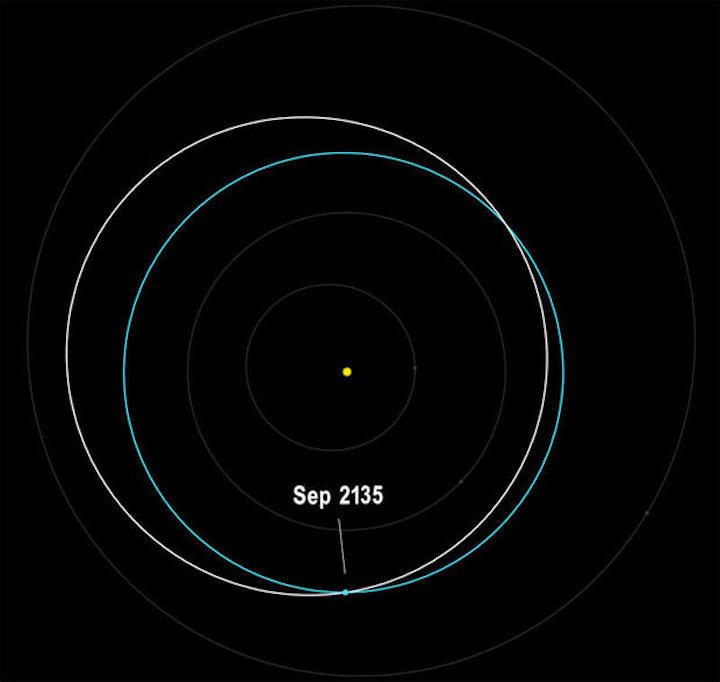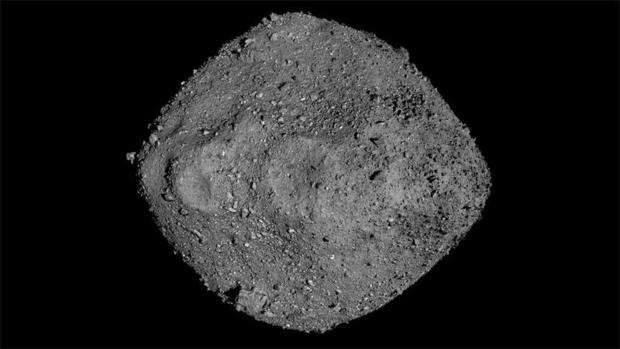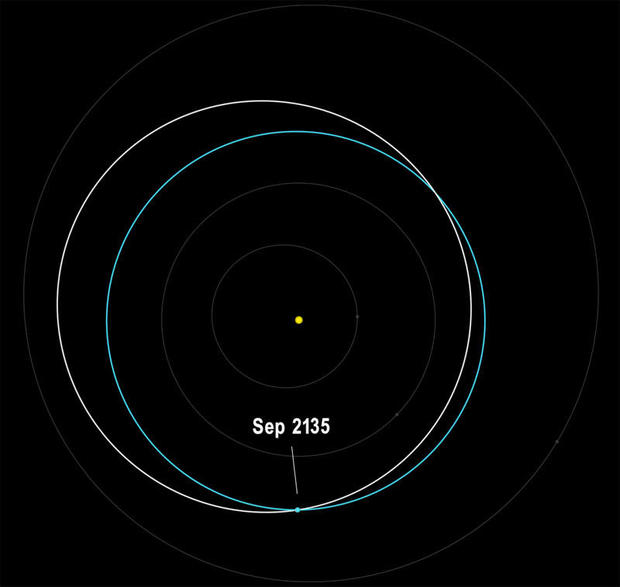13.08.2021

In September 2135, the 1,600-foot-wide asteroid Bennu will pass between the Earth and the moon — and while scientists said Wednesday there is no chance of a collision, Earth's gravity will alter the interloper's trajectory, raising the possibility of an impact during a subsequent close encounter.
The probability of impact depends on how Bennu's trajectory is affected by Earth's gravity, the long-range gravitational influence of other plants and asteroids, and perturbations caused by more subtle factors, including the effects of solar heating.
The latter is known as the Yarkovsky effect, a tiny acceleration produced when the heat absorbed from the sun is radiated back into space as an asteroid rotates from daylight to darkness and rocks cool down.
"The Yarkovsky effect acting on Bennu is equivalent to the weight of three grapes," said Davide Farnocchia, a researcher at the Center for Near Earth Object Studies at the Jet Propulsion Laboratory and lead author of a paper describing Bennu's path in the journal Icarus.
"Think about that. Just three grapes, and that's what's really driving the motion of Bennu into the future, because this acceleration is persistent, its effect builds up over time, and it becomes very significant by the time we get to 2135."
Thanks to NASA's OSIRIS-REx spacecraft, which spent two years orbiting the sun in concert with Bennu and is now heading home with a treasure trove of collected rock samples, researchers have been able to more accurately model those forces to determine Bennu's future course.
Ultra-precise tracking of the spacecraft and its motion around Bennu, reflected in slight changes in probe's radio signals, allowed researchers to nail down the parameters of the asteroid's orbit to within about six feet.
"We measured the distance between the Earth and Bennu, which at times was as large as the distance between the Earth and the Sun, with a precision of two meters," Farnocchia said. "That's the height of a basketball player."
Analysts had identified 26 half-mile-wide gravitational "keyholes" along Bennu's path in the 2135 encounter. If Bennu's trajectory, influenced by the Yarkovsky effect or other factors, passed through one of those keyholes, Earth's gravity could then put the asteroid on a collision course in 2182.
Thanks to the exquisite tracking precision of the OSIRIS-REx mission, the researchers were able to rule out all but two such keyholes to come up with the most accurate assessment of Bennu's impact potential to date.
And the odds remain comfortably low: just a 0.06 percent chance of a collision on Sept. 24, 2182, the date of the most likely near-term encounter, which means a 99.94 percent probability Bennu will miss.
"There is no particular reason for concern," said Farnocchia. "We know that Bennu is still a potentially hazardous asteroid, but the probability is small, and we have time to keep tracking the asteroid and eventually come to a final answer."
Bennu is classified as a "potentially hazardous" body because its orbit periodically intersects Earth's. And while impact by a 1,600-foot-wide asteroid like Bennu would not trigger a mass extinction like the 6-mile-wide body that wiped out the dinosaurs 66 million years ago, it would still cause widespread devastation.
Lindley Johnson, a planetary defense officer at NASA's Planetary Defense Coordination Office, said the crater produced in an impact is typically 10 to 20 times the size of the impacting body.
"So a half-kilometer sized object (like Bennu) is now going to create a crater that's at least five kilometers in diameter and it could be as much as 10 kilometers (6 miles) in diameter," he said. "But the area of devastation is going to be much, much broader than that, as much as 100 times the size of the crater.
"An object Bennu's size impacting on the Eastern Seaboard would pretty much devastate things up and down the coast," he added.
But as the researchers pointed out, the odds of such an impact are remote.
"We should remember that the risk carried by Bennu as an individual asteroid is actually smaller than the risk coming from the undiscovered population of objects of a similar size," Farnocchia said. "And that's why NASA is making a big effort to discover more than 90 percent of the near Earth objects greater than 140 meters (460 feet) in size."
Lindley said about 60% of the presumed population has been identified to to date.
Quelle: CBS NEWS


